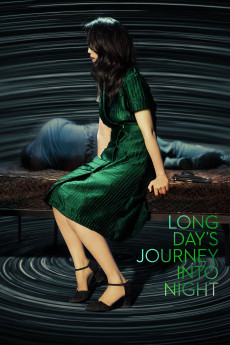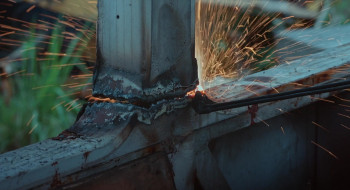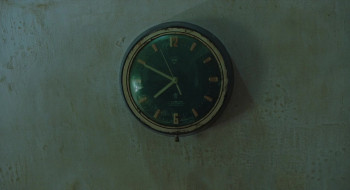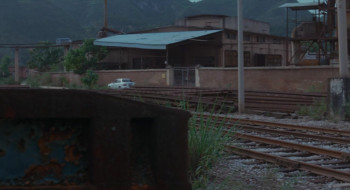"Long Day's Journey Into Night," alternatively known as "Last Evenings on Earth," indeed, is a bewildering movie. Partially, I consider it even a mind-game, or puzzle, picture, as defined by the likes of Thomas Elsaesser. Yet, while there are other avenues through which to interpret it all, and there are some other, fine reviews that do just that, the main means by which I came to grips with Bi Gan's enigmatic tour de force is by way of Alfred Hitchcock's "Vertigo" (1958). Most movies are memories of other movies to a large extent, with the originality being in the re-arrangement, or remembrance, of the former one. Even many supposedly "revolutionary" reels are such in the original sense of the word of returning to a prior place. Undoubtedly, there are other demonstrable influences here, which others have mentioned, including the films of Andrei Tarkovsky and Wong Kar-wai, and there's also the emphasis on the green book doubling the picture's alternate titles that recall the prose of Eugene O'Neill's play and a short story by Roberto Bolaño. Perhaps, if not surely, due to my greater familiarity with Hitchcock's film than with some of those other benchmarks, the prominent references to "Vertigo," however, especially stand out here. Most blatant of these are the woman's green dress and the much-imitated revolving "Vertigo" kiss near the end. More vitally, this reflexivity aids in making sense of the picture.
"Vertigo" is a more accessible and mainstream film that has been around for a long time, infinitely analyzed and so is seemingly easier to decipher. It's a stolen love story, as is the stolen green book here, as is "Long Day's Journey Into Night," despite the supposed deception of its marketing campaign that brought in the lion's share of its box office. Both are shadowy noir (reinforced by the voiceover narration here) in vibrant color where the detective protagonist searches for, to reclaim, that past, lost and stolen love. He is thrust into a vertiginous maze of spinning doppelgängers, dreams, ghosts, memories, time and regrets. Hitchcock's hero literally experienced debilitating vertigo, as well as a psychotic break, amid the rolling hills of San Francisco and up the bell tower; whereas in Bi's picture, the green book's spell is said to make the room spin and spinning a ping-pong paddle makes one fly over the labyrinths of staircases and mineshafts of Guizhou province where the hero here follows in circles redoubled ghosts and women.
As with "Vertigo," too, this one is split into two parts. In the first part, for both of them, the detective shadows the woman, or femme fatale, and investigates the mystery at hand. More so with Hitchcock's camera, but here, too, this is largely composed of the system of looks Laura Mulvey termed the "male gaze." With Hitchcock, this took the form of shots/countershots--i.e. shot of man looking followed by shot of woman he's looking at. Bi doesn't work in the tradition of classical continuity editing to emerge from Hollywood back in the 1910s and which largely continues to this day, though. His, one might say, international art-house style is of a slow cinema (I would agree oft too slow--that elevator lift sequence where the camera operator blatantly waits for his seat to track the character down especially tries the spectator's patience), where mise-en-scène takes prominence over montage. In lieu of edited scene dissection, however, there is camera movement, as well as the role of the camera in shifting between a neutral observer and a shared perspective with a character--almost always the male protagonist. Hence, we see shots of women where the man's presence is acknowledged as off-screen, out of frame, sharing his and the camera's gaze with the spectator. Frequently, these views are photographed through glass, mirrors and puddle reflections, to reinforce the voyeurism and the intentionally artificial perspective as seen through one character and the camera's lens.
This first part is fragmented, non-linear and, here, as based on memories as rusty as the otherwise perplexing views in the movie of rust and damp and dilapidated structures. Clocks are broken. Rain drops. Makeup smeared. Trains stopped by the dislodging of mudslides. Earth mined out. A glass falling off the table to shatter into pieces. Perhaps, this reflects the chaptered, at the reader's own pace, nature of written stories and even told ones, remembered as they are--many characters telling each other stories or stories about being told stories in this one. Thus, the focus on the green book, as well as the photographic snapshot hidden within a broken clock, in the first part. In "Vertigo," too, there was the art of painting, the appreciation by one of the women (Judy) and the designing of by the other (Midge). In both pictures, then, they move from watching, from voyeurism--that is, from our position as spectator--to filmmaking itself in their second parts.
The break in "Long Day's Journey Into Night" is even greater than the nightmare of "Vertigo," with the putting on of the glasses for its virtuoso 59-minute one-shot in 3D and the delayed reveal of the title. This is the Buster Keaton in "Sherlock Jr." (1924) moment (or is it the reverse of "The Purple Rose of Cairo" (1985)?), where he enters the movie of the cinema he's sitting in, watching and dreaming, recalling past movies and other artworks as we should've been following along with, too, throughout. It's where extraordinary planning and nimbleness in tracking with the bulky 3D camera meets the dolly-out combined with zoom-ins of the "Vertigo" effect shots, along with its dream sequence visuals and even those dated rear-projection process shots. Showy, sure, even, perhaps, distracting, but the effects have their functions. Motion pictures depict time like no other art form. It may be cut up (as in "Vertigo"), fragmented beyond the point of normal narrative (the first part here), and presented in real time. Characters continually followed and reappearing (including that humorous donkey), mazes unraveled, the past revealed in cinematic ghosts and the doppelgänger characters of the already reproduced images of motion pictures. Karaoke kept on track by pre-recorded music. "Vertigo" kiss. A firework marking the passing of time.
I'm not quite sure this is a great movie so much as it's a great mystery story--perhaps, such distinction is needless. I mean, the cinematography is some of the best in recent memory, but the deconstruction of its function and that of the narrative itself seems far more rewarding than any mystery therein. It's hard to say that anything meaningful comes from the realization of the child as a ghost from a past murder, the mother and the femme fatale, or the woman of his dreams reappearing, let alone whether what the protagonist experiences is dream or reality. "Mind-game films," for which such checks several boxes, weren't a theoreticized genre in Hitchcock's day. There's hardly any of the psychosexual pervsity found underneath "Vertigo" here, Mulvey's psychoanalytic junk regarding castration anxiety and all included (the limbs of Jimmy Stewart broken were never as vital to the story as they were as metaphor). Hitchcock's film was a mature work, recalling memories of his past features (namely, "Rear Window" (1954)), whereby he reconstructed those dreams and remembrances, remaking his trademarks such as the Hitchcock blonde in the process. Never bravado for its own sake. Nary an obscure reference necessitating shared eclectic tastes. Little lingering to force confronting the confusion of the picture's lack.
Nevertheless, to say "Long Day's Journey Into Night" doesn't rise to the level of "Vertigo" is a slight criticism, indeed. It remains a picture of many levels to appreciate. Even if sense can't be made of it, there are beautiful compositions and motifs, staggering craft and intelligent themes to admire. The destination doesn't so much matter, except that it's exquisite, too, for the journey is what's important. Not so much what was or will be--paying much head to the story here seems an errant errand--but how, including the cinematic reflexivity, one remembers and dreams.
Long Day's Journey Into Night
2018 [CHINESE]
Action / Drama / Mystery / Romance
Plot summary
Luo Hongwu returns to Kaili, the hometown from which he fled many years ago. He begins the search for the woman he loved and whom he has never been able to forget.
Uploaded by: FREEMAN
February 16, 2020 at 07:56 AM
Tech specs
720p.BLU 1080p.BLUMovie Reviews
Vertiginous Labyrinth of Reflected Memories
better luck
The film is rather lovely to look, especially an old and run down town is interest and although the dialogue that seems might make sense eventually. It appears it might not me. On the Blu-ray cover it writes, 'A hypnotic study of hazy memory, lost time, and flight, Long Day's Journey into Night take you on a nocturnal, labyrinthine voyage.' Perhaps better luck than me.












